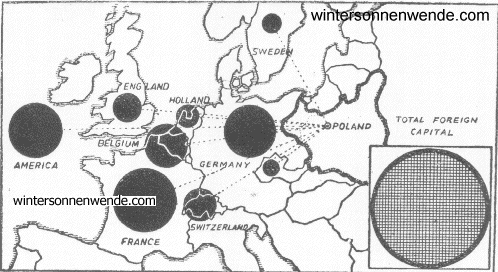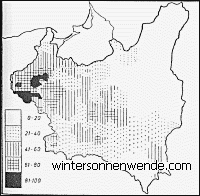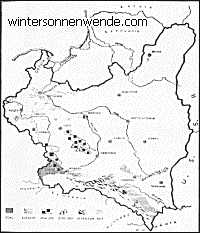 |
 Economic
Life Most people have an entirely incorrect idea of the economic structure of Poland. When the possibilities of this country are being considered, the area and the population are quoted as proof of its latent purchasing power. It is true that there are nearly 35,000,000 people in Poland, and that the area is over 150,000 square miles, but these facts cannot alone serve as evidence of its latent possibilities. A decisive factor for the economic structure of Poland is that there are considerable economic differences between its various parts. These differences are noticeable in all fields. The new Poland is not the result of a process of evolution, but was pieced together after the Great War. The various parts were included in the economic systems of Russia, Austria or Germany, and had their own needs and peculiarities, in accordance with the States to which they previously belonged. A new State was established, but there was a lack of co-ordination, particularly from an economic point of view. There was also a great difference in the life of the people in the several parts.
Big contrasts in population conditions are to be observed in the areas of Posen, the Corridor [17] and Upper Silesia (formerly Prussian) as well as Galicia (formerly Austrian), on the one hand, and the ten gouvernements of Czarist Russia, while the contrast with Vilna and Novogrodek is equally great. In the North-East, the White Russians form a solid majority, while in the South the Ukrainians make up the major part of the population. The Jews form a big percentage of the citizens of the big towns of former Russian sections, while in the district of the Vistula and Warta, solid settlements of Germans are met with. The biggest group, which incidentally has the greatest relative density, is in Galicia, with 8,500,000 inhabitants, and a density of population quoted by Polish books of reference as varying between 110 and 132 per square kilometre. As, however, the thinly populated mountain districts are included, the actual density in the area round Cracow and Lemberg is much greater. The southern parts of the former Russian Poland have also a big surplus population. On the other hand, the formerly German provinces of Posen and the Corridor have a population density of only 80 and 66 per square kilometre, and in purely agricultural areas a density of 40 is not uncommon. The growth of the population is, again, most marked in the parts already overpopulated, while the surplus rural population in Galicia, in the southern part of Russian Poland and in East Poland threatens to become a real danger. [18] For example, Polish figures show that the number of persons engaged in agricultural pursuits per 100 [h]ectares (nearly 250 acres) of arable land is up to 150 in Galicia, but only 40 to 50 in Posen and the Corridor. Conditions in the rural parts of Galicia, as well as in some parts of East Poland and sectors of the former Russian area, can only be compared with the thickly populated land between Osaka and Kobe in Japan. According to my calculations, which are based on reliable statistics, there are nearly 4,500,000 surplus agricultural workers in Poland, but they are restricted to the former Austrian and Russian parts. Conditions in the former German areas are much better. Of course, Upper Silesia must be excepted, being mainly industrial. The problem of this surplus population is one of the troubles with which the Warsaw government has to deal. As yet it has been unsolved. The attempts made to settle part of the surplus population in other parts, as in the new industrial area of Sandomierz, in the limits of the so-called Agrarian Reform, could hardly affect the question to any extent. Incidentally, the transferring of a part of the agrarian population to the towns helped to sharpen the Jewish question, for most of the trade is in the hands of the Jews, who are also well represented among craftsmen and even in the professions. The types of farms and holdings vary with the density of the population. For example, while com- [19] paratively large farms are found in the more thinly populated districts, the areas with a surplus population contain mainly small holdings. These small holdings have been repeatedly divided and subdivided, until they have reached an almost incredible smallness. In some parts of Central Poland and Galicia, holdings under five acres make up 27% of the whole arable land. Again, conditions in this respect are much better in Posen and the Corridor. Not all the peasants in the former Russian and Austrian Poland are real farmers; many have adopted farming as an occupation, and are hardly able to maintain even the most humble existence. In West Poland, farmers enjoy a much better position. But something like 540,000 acres of agricultural property have already been broken up into small holdings in the more prosperous provinces. This measure was carried out as Agrarian Reform, but was really a question of the official minority policy, directed against the German-speaking population, who own much of the arable land there.
There is little industry in East Poland, with the exception of certain local undertakings and, perhaps, wood-working. Most of the industry in Central Poland is concentrated in Warsaw, but the armaments industry is domiciled chiefly in the Radom-Lublin-Kielce area, and there is also the new industrial centre of Sandomierz, already mentioned. The textile industry of Lodz was adapted to the Russian market before the War, and has passed through many difficult phases, now mainly supplying British overseas areas, and thus displacing workers in Lancashire. The same applies to Bialystok, the second most important textile centre. Galicia has mainly ceramic factories, while the petroleum industry is also big; but the petroleum reserves of Boryslav and Drohobycz have been reduced considerably during the last twenty years, and fears are entertained that the supply will soon come to an end. Most of the industry is in West Poland, however.
The Sandomierz industrial centre would appear to have been established partly because Poland's other industrial areas are close to the frontiers. Most of Poland plays a very unimportant part as customer. The best market is in the West, in the former German provinces. This is easily proved by Polish statistics. The consumption of coal per head of the population drops tremendously as one advances Eastwards. There are small holders in the East and South who practically live on their own products, or on such as they can obtain from their neighbours, being hardly able to buy even petroleum for lighting purposes. In some cases salt is actually a luxury, since it cannot be produced at home, but has to be purchased in return for cash. While Poland is large in area, and contains a population of over 34 millions, it is not a potential market in the proper sense of the word, for only the inhabitants of the West really buy such goods as other countries have to sell. It is not only that the small holders have a low purchasing power; factory workers, minor officials, clerks, and the like, are hardly in a better position. Warsaw, a city of 1,200,000 inhabitants, and Lodz, with just half that number, are consumers of foreign products, but with those exceptions the market is in the West. [22] Polish industry has a fairly big capacity, while the home purchasing power is small, so that exports have to be fostered by every possible means. This applies particularly to the heavy industry and to the manufacture of textiles. The big industrial areas handed over to Poland after the War are too big for the country; their natural customers are separated from them by artificial frontiers. To balance this, the Poles control export with the help of Government edicts, preference duties, export premiums, railway tariffs, and the like. Goods are sold far below the costs of production in many cases. This, again, is balanced by raising the price of industrial products in the home market, which, of course, makes it still harder for the people to buy. During the time when the German-Polish Agreement was in force, however, trading on the barter system was done. The railway system also consists of patchwork, which is not surprising when one remembers that it is made up of parts of three railway systems. These three networks were only linked up at certain main points. While there are over 10 miles of railway per 100 square miles in Posen, 11.4 in the Corridor, and 18.5 in Upper Silesia, the other parts are poorly served. For example, voivodship of Warsaw has 5.2, Bialystok 4.2, and some areas even less miles of railway per 100 square miles. The Poles have built some railways since their Republic was founded, but these [23] are mainly in connection with their newly founded port of Gdynia, while others are purely strategic. The roads show similar contrasts. Motorisation makes little progress. In the Western part there were in 1938 3.3 cars per 1,000 of the population, while in the Eastern provinces there were no more than 0.3 cars per 1,000. There are 34.5 miles of consolidated roadway per 100 square miles of land in the West, 21.1 in Galicia, 13.5 in the former Russian provinces, and 3.2 in the East. The condition of the roads in the East is by no means good, although there are slightly better roads in Galicia. A few main highways through Central Poland are well maintained, but apart from them it is only in West Poland that good roadways are met with.
It will thus be seen that no economic improvements of importance have been
made in Poland in the last 20 years. A new port has been fostered, and a certain
amount of building has been done, but on the whole Poland is a backward nation.
Even the rivers are neglected, very little commercial use being made of the
Vistula. Conditions have not bettered since the War in what is now Poland.
Certain progress has naturally been made as technique has advanced, but it is
relatively slight as compared with that in other European lands.
|
|||||||||||||||||||||||||||||||||||











